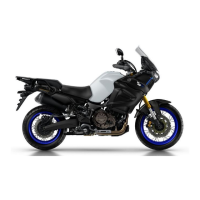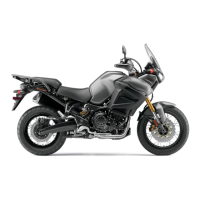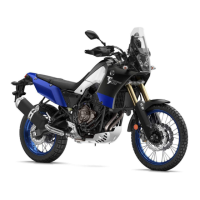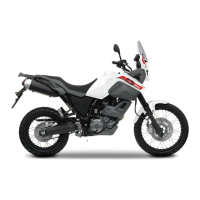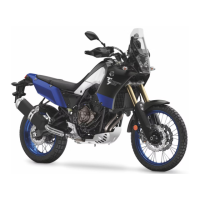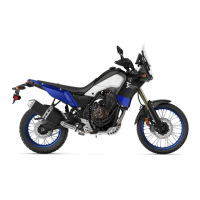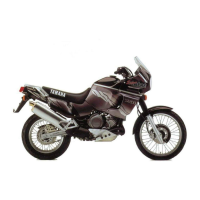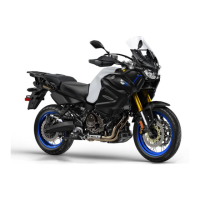
Do you have a question about the Yamaha Super Tenere ABS XT1200Z 2019 and is the answer not in the manual?
| Displacement | 1199cc |
|---|---|
| Bore x Stroke | 98.0 mm x 79.5 mm |
| Compression Ratio | 11.0:1 |
| Fuel System | Fuel injection |
| Ignition | TCI: Transistor Controlled Ignition |
| Transmission | Constant mesh, 6-speed |
| Final Drive | Shaft |
| Rear Suspension | Monoshock, adjustable preload and rebound damping |
| Front Tire | 110/80R19 |
| Rear Tire | 150/70R17 |
| Seat Height | 845 mm |
| Fuel Capacity | 23 liters |
| Wet Weight | 261 kg |
| Width | 980 mm |
| Ground Clearance | 190 mm |
| Engine Type | Liquid-cooled, 4-stroke, DOHC |
| Front Suspension | 43mm telescopic fork, adjustable preload |
| Front Brakes | Dual 310 mm hydraulic disc, ABS |
| Rear Brakes | 282 mm hydraulic disc, ABS |
| Wheelbase | 1540 mm |
| Length | 2255 mm |
| Height | 1410 mm |
Emphasizes owner's responsibility for safe motorcycle operation and operator requirements.
Details pre-operation checks, visibility, and safe riding practices to avoid accidents.
Provides a labeled diagram of the motorcycle's left side components.
Provides a labeled diagram of the motorcycle's right side components.
Shows and labels the various controls and instruments on the handlebars.
Explains the vehicle's anti-theft immobilizer system, including key functions and precautions.
Describes the main switch positions (ON, OFF, LOCK) and how to lock the steering.
Identifies and explains the function of various indicator and warning lights on the instrument panel.
Explains how the cruise control system operates, its speed limits, and activation.
Details the features and operation of the multi-function meter unit, including its various displays.
Explains the electronically controlled engine performance system with touring and sports modes.
Details the function of various switches located on the left and right handlebars.
Explains the operation, adjustment, and unified brake system (UBS) related to the brake lever.
Explains the anti-lock brake system, its operation, and precautions.
Details the traction control system, its function, and how it assists in maintaining traction.
Provides important safety information and recommendations for refueling the vehicle.
Guides on how to adjust the rider seat to a lower or higher position.
Details how to adjust spring preload and rebound damping force on the front forks.
Explains the system preventing engine starts with the sidestand down or in gear, and how to check it.
Details pre-operation checks for the fuel system, including level, line, and tank.
Specifies checks for tire damage, tread depth, and air pressure before riding.
Provides step-by-step instructions for starting the motorcycle engine safely.
Explains how to shift gears, including neutral position, starting off, and decelerating.
Details the critical engine break-in period, recommended RPM limits, and initial maintenance.
Provides a comprehensive chart of regular maintenance and lubrication tasks based on mileage.
Describes how to check engine oil level and quantity, and the importance of oil changes.
Highlights the importance of tire condition, tread depth, and air pressure for safety.
Details how to check and adjust tire air pressure, including cold tire checks and load considerations.
Details how to check brake pad wear using indicators and lining thickness.
Guides on checking brake fluid levels and potential causes for low levels.
Guides on checking the front fork's condition and operation, including inner tubes and oil leakage.
Details battery type, care, and checking lead connections, with safety warnings.
Explains how to replace blown fuses, including fuse box locations and amperage warnings.
Introduces troubleshooting charts for common issues and emphasizes using genuine parts and dealer service.
Explains how to handle engine overheating, including radiator cap safety and checking coolant levels.
Provides detailed steps for washing the motorcycle, including rinsing, detergent use, and avoiding high-pressure water.
Advises on proper storage conditions, fuel stabilization, and protection against dust.
Explains the importance of recording Vehicle Identification Number, Engine Serial Number, and Model Label.
Shows the location of the diagnostic connector used for vehicle data retrieval.
